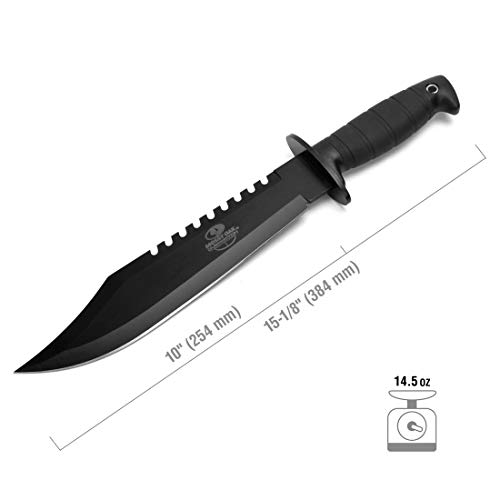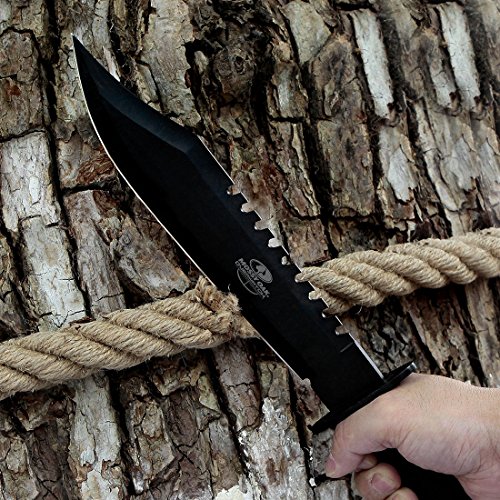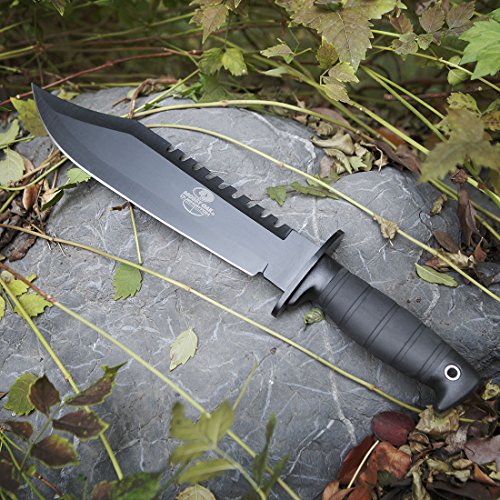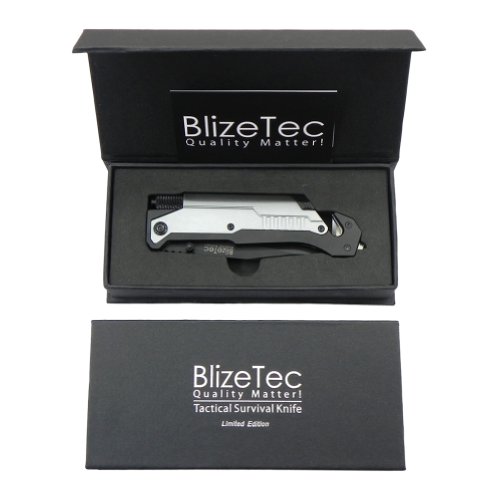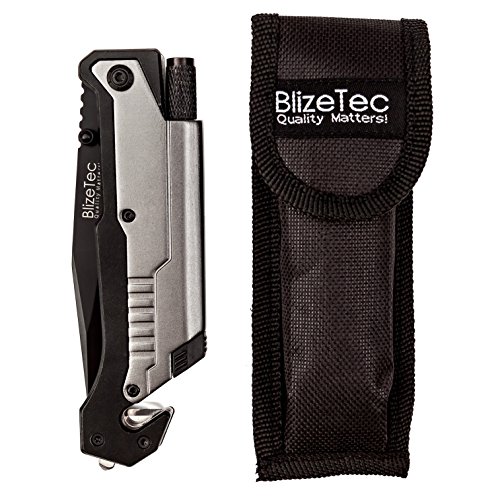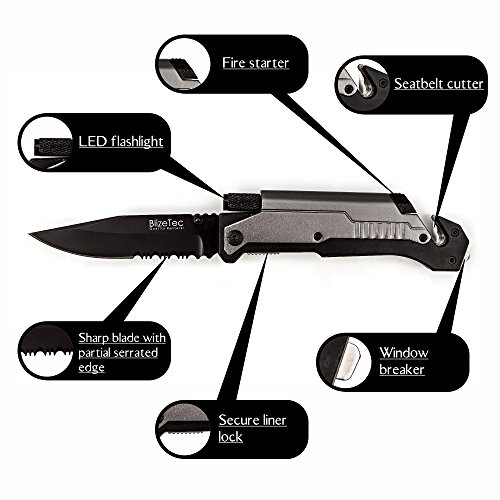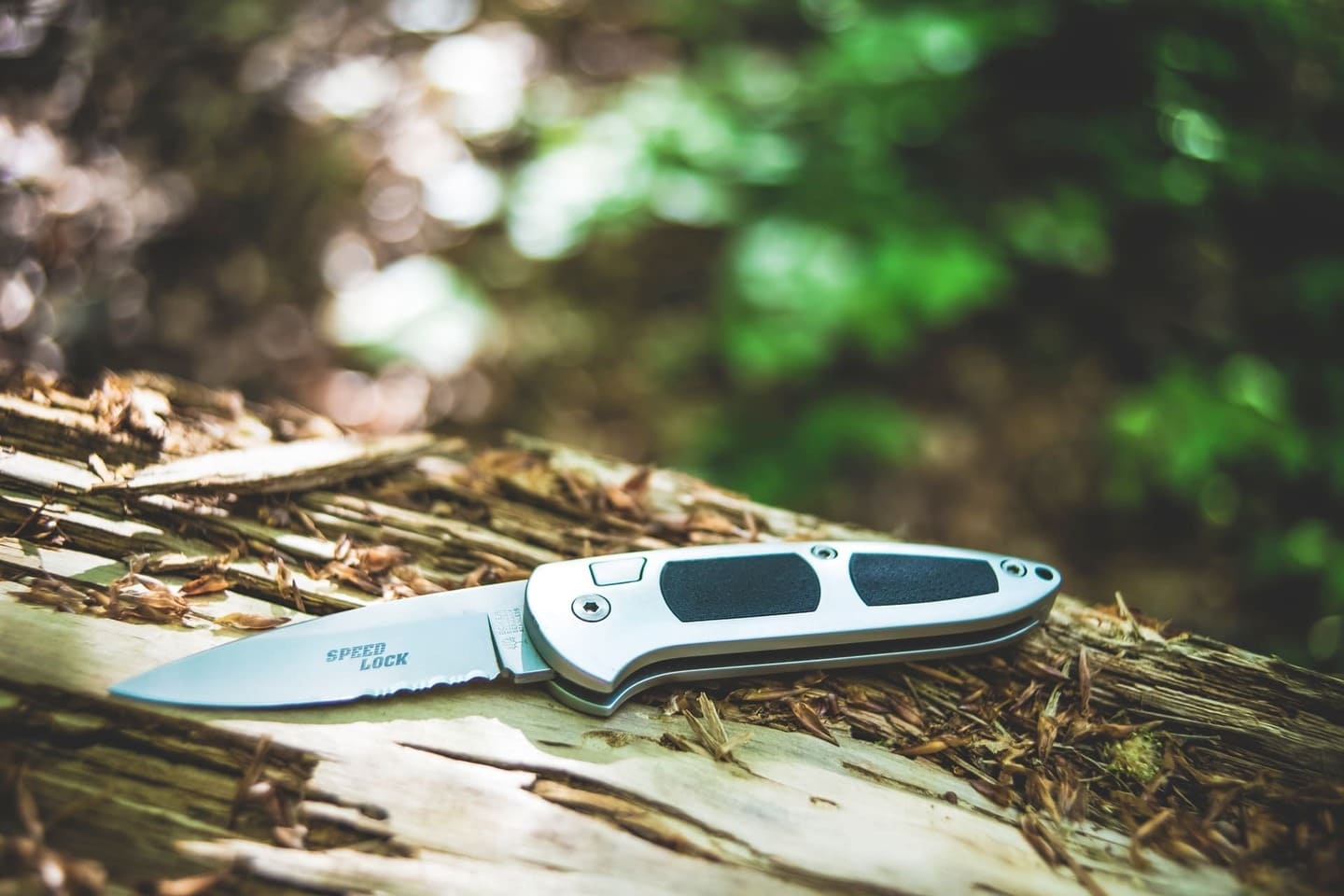Having the correct knife by your side can often be the difference between surviving in an extreme situation, or not.
We’ve reviewed the best survival knives, so that you can select your ideal blade and take your bushcraft and survival skills to the next level.
Whether it’s for defence, hunting, or creating shelter, any good survivalist will tell you, a quality knife is absolutely imperative.
Questions surrounding the best types of knives for survival situations are common and it can often be difficult to cut your way through the ‘fluff’ that consumes the internet, from so called ‘survival experts’ (no pun intended).
If you’re reading this now, you’re looking for answers to your questions.
Questions like, ‘what is the best survival knife?‘, ‘what is the best type of handle for a survival knife?‘, or ‘what carbon rating should a survival knife be?‘.
In this review, we’re going to answer all of these questions and take you through the best survival knives on the market.
P.S. If you’re in a rush, check out our quick comparison table below to see our top rated survival knives.
If not, let’s begin…
Morakniv Bushcraft Survival Knife
Morakniv is one of the oldest Swedish blade and knife manufacturers. They’ve been making high-quality knives since 1891, and they are one of the most regarded manufacturers in the bushcraft society.
The Morakniv Bushcraft blade is no exception from the usual Mora quality. It is made of HRC 56-58 high carbon steel, and it is designed to withstand the high stress of batoning too. The coating is a nice edition too – it is meant to protect the knife from corrosion and rust. It wears off relatively easy with hard use, so to protect the knife, it’s always better to oil the blade after use.
The handle is, however, not the best we’ve experienced so far. While the blade is superb and comes well sharpened from the factory, the handle is a bit of a letdown. It’s not terrible by any means, but it is made of plastic that is not particularly grippy when wet. Rubber would be a much better option – it just feels better in hand. A prime example are Gerber survival knives – they have superb handles that are comfortable and offer excellent grip when wet.
Otherwise, the Morakniv comes decently equipped – it comes with a useful plastic sheath that has a little mount for a fire starter. The firestarter is excellent quality, and it is good for up to 7000 strikes, and it works even when it’s wet. Just don’t forget the scrape the protective coating before use, or it just won’t work.
Overall, the Morakniv is a solid choice for bushcraft enthusiasts and survivalists alike. Despite the sub-par handle, it is a decent survival knife made of high-quality steel. Morakniv is a proven brand, so you can rest assured that the blade won’t let you down when you need it the most.
Read the full post_title; ?> review
Pros
- Hardened Steel Blade
- Reputable manufacturer
- Well sharpened blade from the factory
Cons
- Sub-par plastic handle
Gerber StrongArm Fixed Blade Knife
Here we go with another Gerber product on our best survival knives comparison – the StrongArm Fixed Blade Knife. It is a bit better than Gerber’s Bear Grylls version, and I’ll explain why in a second.
Let’s start with the blade material. While the Bear Grylls’ blade is made of high carbon steel without any more indications about the quality of the material, the StrongArm blade is made of very high-quality material – 420HC steel. The 420HC steel is one of the strongest and most durable steels on the market, and it is a genuinely premium metal.
The Gerber’s StrongArm survival knife is a full-tang blade with a diamond textured rubber grip. It has a unique feature built in the handle – there is a sharp striking pommel at the end of it. It can prove extremely useful in survival and rescue operations where you need to shatter a hard surface like a car window or thick ice, for example.
The sheath of the StrongArm knife is probably one of the best we’ve seen so far. It offers more than a few unique mounting options. You can mount it on a MOLLE gear, carry it on your ankle, wear it on your belt.
Overall the StrongArm knife made by Gerber is a superb product trusted by military and rescue personnel. They recently upgraded the steel to a 420HC grade – vastly improving the strength and the edge retention of the blade. The striking pommel can be the difference between life and death in certain situations, and the excellent is one of the best we’ve seen equipped lately. It is a solid choice for bushcraft, camping, and even military use.
Read the full post_title; ?> review
Pros
- Full tang blade
- 420HC steel blade
- Striking pommel handle
- Detachable belt hoops and sheath with MOLLE strap
- Made in USA
Cons
- Uneven blade angle from the factory
- Not suitable for heavy-duty chopping
Mossy Oak Fixed Blade Survival Knife
The Mossy Oak blade is another heavy hitter on our best survival knives list. Compared to the Gerber knife, the Mossy Oak is a much larger and imposing blade.
The blade itself is made of 440C stainless steel that ensures excellent edge retention, rust resistance, and hardness of the material. The blade itself is clip point compared to the drop point of the Bear Grylls above.
The Mossy Oak knife handle is made of soft rubber for improved grip and handling. It feels incredibly comfortable in your hand, and the high friction surface ensures that the blade will never feel awkward.
The knife comes in a generous package. In the box, you’ll find a fire starter, which works quite well, a mini-sharpener that comes useful when trekking long distances and a super sheath made of heavy-duty nylon.
Overall the Mossy Oak 15 inch fixed blade is a superb survival knife that you can depend on in even the most challenging situations. You can saw off thicker branches with the back of the knife, which is serrated ⅔ of the way. You have a fire starter and a sharpener included, and if you are on the market for a large fixed blade survival knife, it doesn’t get any better than the Mossy Oak product.
Read the full post_title; ?> review
Pros
- Durable 440C Stainless Steel Blade
- Soft but solid handle
- Firestarter and sharpener incorporated in the sheath
- Budget-friendly
- Attractive exterior
Cons
- Not a full tang blade
- Concerns about durability
Gerber Bear Grylls Survival Knife
The Bear Grylls survival knife is part of a series of survival tools and gadgets made with the approval of the famous TV presenter. Made by Gerber, which is one of the most notable names in the blades and home tools industry, guarantees the quality and the craftsmanship of this product.
It is a half-serrated drop point blade made of high carbon steel with am ergonomic rubber grip. The serrated part of the edge is ideal for cutting rope and sawing off small branches. The grip is textured and feels very solid it the hand – there are minimal chances of slippage when using it.
The base of the handle has a stainless steel pommel that is ideal for hammering. While the blade is not particularly heavy to be used as a hammer on its own, a steady grip will make it into a fairly decent mini-hammer in a case of emergency.
The coolest part of the package is the fire starter. It allows you to start a fire in the wild without the need for a match or a lighter. It is a thin ferrocerium rod that once rubbed across the striker notch will produce a rain of sparkles that can quickly light up a stack of dry leaves, for example.
Overall, the Bear Grylls survival knife is a great product that comes with a very reasonable, IMHO, price tag. It is made by Gerber – one of the most prominent blade and tool manufacturers in America. The blade feels solid in hand, the blade is sharp and durable, and the quality of the sheath is second to none – military grade. The ferrocerium fire starter makes this an irresistible package.
Read the full post_title; ?> review
Pros
- Made by Gerber - one of the best brands
- Half serrated blade has many uses
- Solid handle with a excellent grip
- Fire starter included in the kit, to undertake other tasks
- Backed by Bear Grylls himself
Cons
- Firestarter is easy to fall off the sheath and get lost
- Reports of quality issues with the handle
BlizeTec Tactical Survival Pocket Knife
The BlizeTec is one of those all-in-one devices that claims it can do it all. But can it do everything well? Stick around, and we’ll find out together.
The BlizeTec has a lot of bells and whistles, there is no question about it. It has the following features and tools all incorporated in a single device:
- Survival pocket knife
- LED Flashlight
- Firestarter
- Seatbelt cutter
- Window breaker
- Half serrated edge
- Secure liner lock
The BlizeTec survival knife features a drop point style blade that is made of high-quality steel designed to withstand batoning and impact. The blade is half serrated, making it ideal for cutting ropes, belts, and even wood for starting a fire. The seatbelt cutter is incredibly useful for rescue operations, and in the unfortunate case of a car accident – you can cut your seatbelt easily if you get stuck in the car.
Usually, folding knives always have a bit of play when extended, but that’s not the case with the BlizeTec survival knife. It feels solid in hand – it almost feels like a fixed blade knife. To be honest, probably most rat tail handle knives will fail way before this folding blade – it is that good.
The compact size and the light weight are an added bonus – you can carry it in a pocket or clip it to your belt. It can’t be compared with the Gerber StrongArm in terms of mounting options, but the clip feels reliable. In case it bends away, you can always take it off and straighten it if needed.
The flashlight that comes with it is rated for up to 12 hours of continuous light, which is impressive in a survival situation. The be fair is not the brightest flashlight on the market, but it is bright enough to see where you’re going in a dark alley or a wooden trail. Just as every bushcraft knife on this list, the BlazeTec comes with a firestarter that works very well.
Overall, the BlizeTec tactical survival knife is a great product at a very reasonable price. It feels solid and well designed. While the flash is not the best out there, it provides enough light to see where you’re going in the dark. The seatbelt cutter is an added bonus!
Read the full post_title; ?> review
Pros
- Lightweight and portable
- Solid feel in your hand - no wobbling
- Flashlight mounted on the handle
- Window breaker
- Reasonable price
- Ideal for vehicle use
Cons
- The flashlight is somewhat weak
- The case is not great
The Best Survival Knives: Your Buyer’s Guide
By now you’ve probably ear-marked your favourite survival knife, but probably want a little more information – that’s why you’re still reading, right?
Well, you’re in luck…
We’ve created an in-depth, informational buyer’s guide on finding the best survival knives, so if you’re still unsure or you have any final questions, this buyer’s guide should do the trick.
Blade Material – Stainless Steel vs High Carbon Steel
Your ideal blade material really depends on your intended use.
In essence, different survival knives are better at different tasks and although the are some good ‘all rounders’, generally speaking, these types of knives will never be the best at any specific task.
But, before you opt for a specialist survival knife, bear in mind that what it makes up for in terms of specialisation (being exceptional at a specific activity), it’ll almost certainly lack in the majority of other areas.
It really does depend on your intended use, and how ‘specialist’ you intend to go.
For example, a knife which is excellent for slicing tomatoes would almost certainly be useless for batoning wood.
There are some excellent universal survival knives and if you’re looking for a knife that can generally handle most tasks to a good standard, any the survival knives we’ve reviewed above are will be an excellent addition to your survival arsenal.
Stainless Steel Survival Knives
Stainless steel blades are rust and corrosion resistant; more so than high carbon steel blades.
This is because they are generally made up of at least 12% chromium.
This is caveated however, by the fact that stainless steel blades are often softer than their high carbon steel counterparts.
Again, this brings various pro’s and con’s.
For example, due to the softer stainless steel blades, they often lose their edges quicker (con), which is again caveated with the fact that they are easier to sharpen (pro).
Stainless Steel Blade Advantages
Durability: Stainless steel blades are often tougher (not harder, but tougher) than high carbon steel alternatives.
There’s an ongoing debate around the definitions of the two (harder and tougher), in context to survival knife blades, but generally speaking, the two are considered different in the world of survival knives and bushcraft.
Flavor Preservation: If you’re going to be using the knife for food preparation, then generally, stainless steel blades are considered a good option.
This is because they do not require any protective or non-stick coatings, meaning cross-contamination with your food (that metallic taste) is less likely to occur.
Recyclable: Out of everything we (humankind) produce today, stainless steel remains one of the most recyclable materials.
Due to the significant use of stainless steel in almost everything that we build, you can very easily recycle your survival knife should you damage it in some way (which is unlikely, I might add).
Appearance: As much as people don’t like to admit, one of the big factors in any survival knife purchasing decision, is whether or not the knife (blade) looks good.
And with stainless steel, you can almost certainly guarantee a quality looking blade many, many years after purchase. And, of course, with less maintenance time, comes more time to do what you love doing – actually using the knife.
High Carbon Steel Survival Knives
Carbon is one of the hardest elements known to man, and high carbon steel blades emulate this feature.
Retaining blade edge is of little concern with high carbon steel, simply due to its exceptionally strong and hard nature.
Again, less time on maintenance and more time on using the thing…
However, this is caveated (once again) with the fact that high carbon steel blades do not contain chromium, meaning rusting can be a huge issue (as chromium is what ensures that stainless steel blades stay virtually rust-free).
Avoiding rust on high carbon steel blades, however, is not a major concern, providing you maintain the blade regularly. Blades should be cleaned thoroughly after every use, and also protected against moisture prior to storage.
High Carbon Steel Blade Advantages
Sharpness: Put simply, you simply cannot out-perform high carbon steel blades when it comes to sharpness. Even with years of experience at sharpening stainless steel blades, you’ll still not achieve the same standard as their high carbon counterparts.
Improved sharpness increases the accuracy of your cutting and reduces the effort you have to put in, thus making the task of using the survival knife safer.
Affordability: Here’s the bottom line; price is a factor. The price of a survival knife depends on a number of factors, most of which we’ve covered in one form or another in this article.
But, if budget is a major factor in your survival knife purchasing decision, then you’re probably best opting for high carbon steel, as opposed to stainless steel. They tend to be more affordable, without compromising on quality.
Hardness: Precision cutting can matter, and the hardness of a blade can make all of the difference.
High carbon steel blades are significantly harder than stainless steel blades, meaning they are more dependable when making precision cuts.
This is why the majority of blades used on hunting knives are made from high carbon steel.
Edge Retention: When considering edge retention, one attribute matters above all else; hardness. I know, right.
We’ve already discussed hardness, but it’s worth touching on this point separately, as high carbon steel blades are perfect for retaining that razor sharp edge for longer.
This reduces the time spent sharpening your blade and ensures that, when you need it most, your blade will be ready.
Survival Knife Blade Design
Blade design is one of the most important choice when it comes to selecting the best survival knife.
Again, this is something that is heavily dependant on how you intend to use the knife and whether you’re looking for a specialist or multi-task tool.
Three of the most popular blade designs for survival knives are as follows:
All three designs are based on. the principle of bringing the blade closer to the centerline of the knife, allowing for greater control over the blade.
These designs are intended to lighten the edge and improve the balance of the blade.
Clip Point Blade Design
This blade design is usually found on larger survival knives and bowie knives. The blade curves up at the front, and it is best suited for self-defence.
The clip point design is also ideal for skinning game and larger animals. A downside however, is that due to the size of the blade, it is not ideal for multipurpose use.
This survival knife design has its strengths, but general use isn’t one of them.
Drop Point Blade Design
This blade design is better suited for cutting and carving, so makes an excellent tool for survivalists who regularly carry out food preparation.
Due to the smaller size of the blade, it is more stable and easier to use.
The tip of the blade drops off at the edge, giving the knife a more solid feeling during use.
The drop point blade design is the preferred choice for people looking for a. multipurpose blade, and can handle chopping wood, carving, and even sawing off branches from trees.
Spearpoint Blade Design
As the name suggests, this blade design resembles a needlepoint, making it excellent for piercing and stabbing.
It is best suited for serious survivalists who may find themselves in extreme or hostile situations, including self defence.
During my time as a Royal Marine’s Commando, I used to carry this type of blade, termed a ‘Commando Dagger’ while patrolling on operations.
In a close quarter combat situation, this type of knife could literally be a ‘life saver’.
The blade is symmetrical and usually has a point that is aligned with the blade centerline.
It is not effective for general bushcraft or multipurpose use, as it’s unsuitable for a variety of tasks.
Folding Survival Knives vs Fixed Survival Knives
Again, this decision will be driven by the survival knives intended use (sounding like a broken record, I know).
If you want a survival knife for occasional use, in case of an emergency or accident, for example, then a folding knife may well suit your purpose.
However, on the whole, folding blades just do not perform well during robust and frequent use, especially during genuine survival situations.
For seasoned survivalists or those who intend to use the knife regularly and under pretty intense conditions, our recommendation would always be to opt for a. solid, fixed blade, with a. full-tang.
They’re generally much more robust and will serve you better in a real life survival situation, should you ever be unlucky enough to encounter one.
Fixed blades will perform better when carrying out more hardcore tasks, such as chopping wood, splitting logs, and digging, etc.
Even the most robust folding blades can become damaged through the above activities, and so it’s really worth considering your intended use prior to making your decision.
Survival Knife Blade Length
With bushcraft related tasks varying so much, it’s no surprise then, that the ‘ideal’ blade length for each respective task can vary significantly, too.
It really is a tricky one…
It is generally recommended that a. survival knife blade should measure between 4 and 7. inches.
Anything bigger may prove quite cumbersome and become a hindrance when performing tasks like skinning small game or setting delicate snares, etc.
Anything smaller, and you run the risk of significantly limiting your ability to perform necessary tasks out in. the bush, such as batoning wood, etc.
Consider your options, here, and think long and hard about how you intend to use the survival knife.This will assist you in your decision in choosing the best survival knife for your needs.
Things to consider include:
- Frequency of use
- Duration of use
- Types of activities most likely to be performed
- Length of journeys and carriage of the knife
Survival Knife Blade Thickness
Although it may not seem like much weight now, the added weight of a thicker (and heavier) survival knife, once coupled with all of your additional survival equipment, can quickly add up.
With survivalists (and real life survival situations), it’s hard trying to stay on the right side of the fine of:
- Being under prepared and ill-equipped due to carrying insufficient equipment.
- Overburdening yourself with unnecessary kit, slowing yourself down, and increasing the likelihood of. injury during travel.
You should always aim to reduce your weight, while maintaining the required equipment.
The ideal blade thickness for a survival knife should be between 0.17 and 0.25 inches.
A blade thicker than 0.17 inches should be strong enough for most, if not all, uses.
Any thicker than 0.25 inches may not be comfortable for delicate work, and most blades thinner than 0.17 inches won’t be suitable for heavy-duty work.
Again, weight up your options and understand when, where, and how you’ll be using your survival knife.
Blade Tang – Full Tang vs. Half Tang vs. Rat Tail Tang
There are a number of variations when it comes to blade ‘tang’.
But first, it’s probably worth diving into more detail on what ‘blade tang’ actually means…
The tang of a blade is essentially the part of the blade that flows from the projecting shank, into the handle of the knife.
In essence, it’s the part of the blade that runs through (or sits within) the handle of the survival knife.
There are three main types of blade tang:
- Full Tang
- Half Tang
- Rat Tail Tang
Full Tang
The golden rule of survival is always to go full tang.
Full tang describes one solid blade, in which the width of the blade within the knife handle is the same (or almost the same) as the width of the blade protruding from the knife handle.
The blade will also run the full length of the survival knife handle.
Generally, on full tang survival knives, the two pieces of handle are pinned to the tang (the piece of the blade that sits within the knife handle).
There are no welds, screws, or glued parts joining any parts of the blade; it is one object.
This type of tang is generally the most robust, and is usually the ‘tang of choice’ for survivalists.
Half Tang
A ‘half tang’ (also known as partial tang), means that the blade tang (the piece of the blade that sits within the knife handle) ends somewhere around the middle of the handle (length), but as with a full tang, it runs the full width of the knife handle.
While most reputable manufacturers ensure the quality of the partial tang, there is always a chance of the blade tang becoming damaged and separating from the protruding blade itself.
Another downside of a partial tang, is that if the blade gets damaged, the blade will quickly become unusable.
Rat Tail Tang
A ‘rat tail tang’ (also known as the stick tang) is, in terms of robustness, is usually the least reliable.
As the name suggests, it resembles a rat’s tail flowing from its body (the thinner tang flowing from the protruding full width blade).
The tang usually runs the full length of the survival knife handle, but is extremely thin in relation to the width of the handle itself.
More often than not, the stick (tang) is welded to the blade.
This reduces the robustness of the knife and increases the chances of damage or breakage during intense use.
A ‘narrowing tang’ is similar to the partial tang, but the tang itself narrows inside the handle.
This technique is. often used with cost in mind – to reduce the cost of the blade by reducing the amount of high-quality steel present in the handle.
Generally, not ideal for survival situations as they are even less robust than the rat tail tang.
Survival Knife Handle Material – Rubber vs. Plastic vs. Synthetic
It’s easy to get carried away when talking about steel quality, sharpness, edge retention, and blade design.
But it’s important not to overlook the criticality of ensuring your survival knife’s handle is fit for purpose.
It is vital that you choose a handle that works for you and your intended uses, and doesn’t cause your pain, irritation, or blistering, as this will render the survival knife almost useless.
A general rule of thumb is to steer clear of hollow and/or plastic handles.
They may seriously compromise the overall integrity of the blade.
Stay away from metal handles, too, as metal conducts heat, and may therefore cause issues when using the knife around heat (fire).
Similarly, in extremely cold environments, metal knife handles will become and may become difficult to hold, and, in freezing conditions, could even become dangerous if in contact with bare skin.
The best choice for a survival knife handle is a modern synthetic material.
The most popular ones are Micarta, Kratona, and GRN.
Dense rubber works too, bit it’s not nearly as robust as GRN.
Recap
So, there you have it.
The definitive guide to choosing the best survival knife.
Hopefully we’ve answered all of your questions, but if you have any more, please let us know in the comments below and we’ll get it answered as soon as possible.
Still unsure on which one to pick?
Our recommendation goes to…
The Gerber StrongArm tactical survival knife.
It comes with an excellent textured grip that is almost indestructible.
The striking pommel at the end of the handle can easily shatter windows or break other hard surfaces, and the mounting options are limitless, too, as the blade is designed with military use in mind.
Thanks for reading.
Share the Love
If you found this post useful, please let others know about it by sharing it.


















